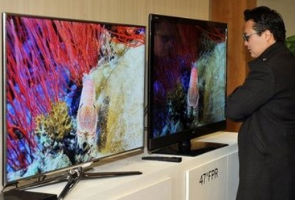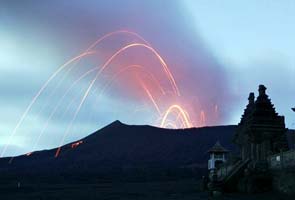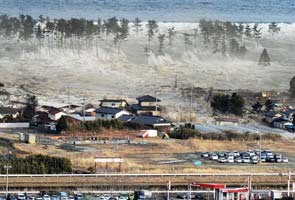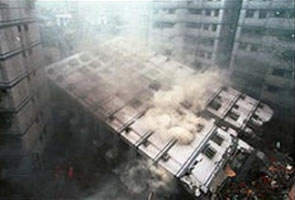Tokyo: A massive earthquake struck Japan on Friday, setting off a devastating tsunami that swept over cities and farmland along the northern part of the country and threatened coastal areas throughout the Pacific.
(In Pics: Japan earthquake triggers tsunami)
Walls of water swept away houses and cars in northern Japan and pushed ships aground. Trains were shut down across central and northern Japan, including Tokyo, and air travel was severely disrupted. A ship carrying more than 100 people was swept away by the tsunami, Kyodo News reported.
Prime Minister Naoto Kan said the disaster caused major damage across wide areas.
Associated Press reports Japanese police say 200 to 300 bodies have been found in a northeastern coastal area.
(Japan PM: Quake caused major damage)
The United States Geological Survey said the earthquake had a magnitude of 8.9, which the agency labeled a "mega" quake. The tremor occurred at about 230 miles northeast of Tokyo and at a revised depth of about 17 miles, the American agency said. The Japanese Meteorological Agency said the quake had a magnitude of 8.8. News reports said it ranked among the biggest in a century.
(Watch: Fire at oil refinery, Tsunami strikes airport)
Tsunami waves swept away houses and cars in northern Japan and pushed ships aground. Trains were shut down across central and northern Japan, including Tokyo, and air travel was severely disrupted. The government held an emergency session to coordinate response as the death toll rose to 23 in five prefectures, officials said. At least 30 people were injured in the cities of Tokyo and Osaka.
(Watch - Japan: The day the earth shook)
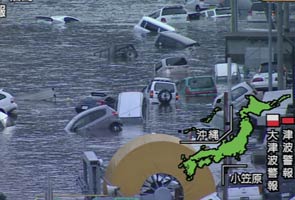
The quake occurred at 2:46 p.m. Tokyo time and hit off Honshu, Japan's most populous island. The quake was so powerful that buildings in central Tokyo, designed to withstand major earthquakes, swayed.
"This tremor was unlike any I've experienced previously, and I've lived here for eight years. It was a sustained rolling that made it impossible to stand, almost like vertigo," said Matt Alt, an American writer and translator living in Tokyo.
Television images showed waves of more than 12 feet roaring inland. The tsunami drew a line of white fury across the ocean, heading toward the shoreline. Cars and trucks were still moving on highways as the water rushed toward them.
(Watch: Biggest quake in 140 yrs)
The floodwaters, thick with floating debris shoved inland, pushed aside heavy trucks as if they were toys, in some places carrying blazing buildings toward factories, fields, highways, bridges and homes. The spectacle was all the more remarkable for being carried live on television, even as the waves engulfed flat farmland that offered no resistance.
The force of the waves washed away cars on coastal roads and crashed into buildings along the shore. Television footage showed a tsunami wave bearing down on the Japanese coastline near the community of Sendai.
NHK television transmitted aerial images of columns of
flame rising from an oil refinery and flood waters engulfing Sendai airport, where survivors clustered on the roof of the airport building. The runway was partially submerged. The refinery fire sent a plume of thick black smoke from blazing spherical storage tanks. A television commentator called the blaze an "inferno."
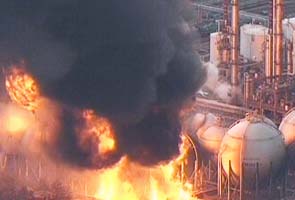
The images showed survivors in a home surrounded by water, waving white sheets from the upper floors of buildings. News reports said the earthquake had forced the Tokyo subways to empty while airports were closed and many residents took to the streets, desperately trying to leave the city.
Initial television coverage from coastal areas showed very few people actually in the water. The initial impact of the wave seemed to have been enormous, tipping two huge cargo vessels on their sides at one port and tearing others from their moorings.
Smaller vessels, including what looked like commercial fishing trawlers, were carried inland, smashing into the superstructure of bridges as the waters surged. A senior Japanese official said foreign countries had offered to help and Japan was prepared to seek overseas assistance.
A second major earthquake of 7.4 magnitude was reported as aftershocks shook the region. Japanese media reported mobile phone networks were not working.
Power blackouts were affecting about 2 million residents around Tokyo alone, the government said. Cell phone service was severely affected across central and northern Japan as residents rushed to call friends and relatives as aftershocks struck.
The Pacific Tsunami Warning Center extended a tsunami warning across most of the Pacific Ocean, and said the tsunami would threaten coastal areas of Russia, Taiwan, Hawaii, Indonesia, the Marshall Islands, Papua New Guinea and Australia later in the day. The agency, based in Hawaii, added the west coasts of the United States, Mexico, Central America and South America to the list of countries that given tsunami alerts.
(Read: Tsunami warning for 19 countries)
Russia's Emergency Situations Ministry said that the tsunami had reached the Russian-controlled Kurile Islands north of Hokkaido, Japan at about 6 p.m. local time. "The tsunami has reached three population centers in the Kurile Island chain. The average height of the wave has been recorded at less than one meter. There have been no casualties or damage," the ministry said in a statement. In response to the tsunami threat, about 11,000 people have been evacuated from four population centers in the Kuriles, the ministry said.
Japanese television showed major tsunami damage in northern Japan. Public broadcaster NHK reported that a large ship swept away by the tsunami rammed directly into a breakwater in Kesennuma city in Miyagi prefecture. Video footage also showed buildings on fire in the Odaiba district of Tokyo, The Associated Press reported.
"It just seemed to go on and on," Katherine Wallace told the BBC, who was in an office building in Tokyo, said of the quake tremor.
Several quakes have struck the same region in recent days, including a 7.3 magnitude one on Wednesday.
Defense Secretary Robert M. Gates, was briefed on the disaster during a trip to Brussels. Geoffrey Morrell, the Pentagon press secretary, said there were no reports of damage to American military facilities or naval vessels.
At the headquarters of the Navy's Seventh Fleet in Yokosuka, Japan, sailors were preparing for a potential tsunami. "We've issued instructions to our pierside ships in Yokosuka to stand by their lines to be prepared to quickly adjust them as necessary to prevent damage during any resulting tsunami," said Cmdr. Jeff Davis, the Seventh Fleet spokesman.
It was unclear on Friday morning to what extent the American military in the Pacific was preparing to help with disaster response.
The Hang Seng index in Hong Kong and the Straits Times in Singapore slumped after news of the quake, ending about 1.6 percent and 1 percent down, respectively.
(Watch: Financial markets hit by Japan quake) 

 Click to Expand & Play
Click to Expand & Play